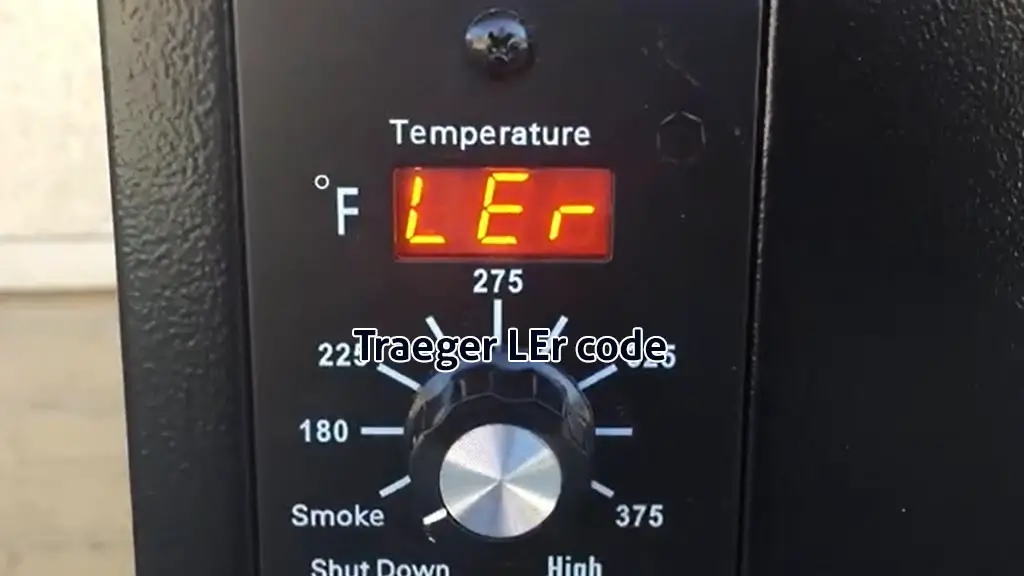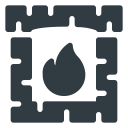The Traeger LEr code appears when the grill’s internal temperature drops below 125°F (52°C) for more than 10 minutes. When this happens, the grill automatically shuts down to protect its components.
The main reasons for the LEr code to show up are:
- Incorrect grill startup procedure.
- Cold or windy weather affects grill performance.
- Low-quality or wet pellets.
- Issues with the firepot, auger, or hopper.
- Blockages in the chimney.
- Faulty parts like the induction fan or hot rod.
I’ll walk you through these common causes and provide effective solutions to clear the error. Let’s dive in and get your Traeger grill back in action!
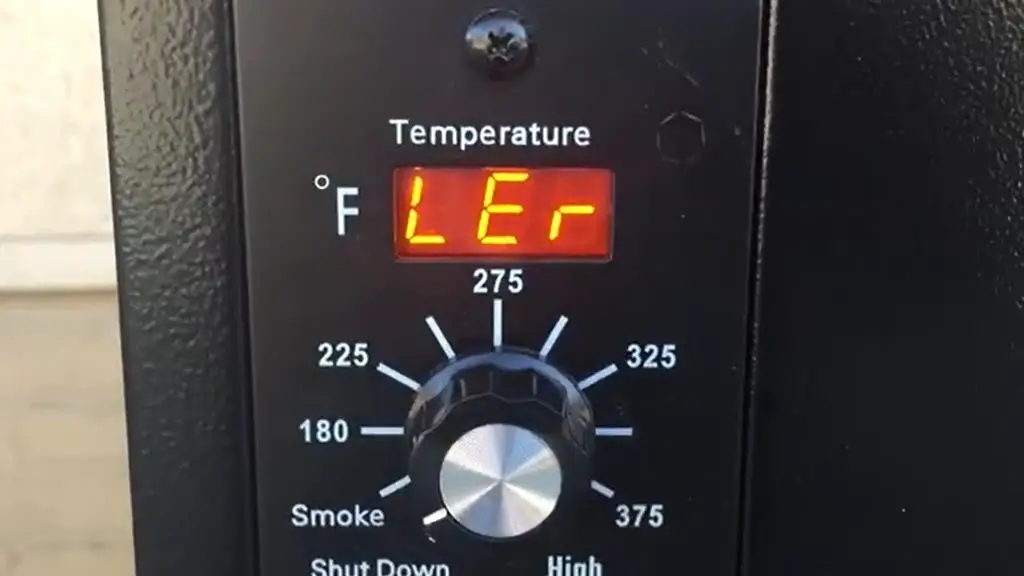
Traeger LEr code [How To Reset & Fix]
Let’s understand the LEr code a little bit better before jumping into the diagnostics right away. So, what does Traeger code LEr mean?
The LEr error code stands for Low Error Reading. It pops up on Traeger grills with a 3-digit digital controller when the internal temperature drops below 125°F (52°C) for more than 10 minutes.
This is the grill’s saying, “Something’s not right.” When this happens, the safety system kicks in, and you’ll see “LEr” on the controller’s screen.
Once the LEr code shows up, the grill shuts down some key parts. The auger motor, fan, and igniter all stop working, so your grill won’t function.
However, the controller stays on since these grills don’t have a sleep mode. It’s like the grill is awake but refusing to work until you fix the problem.
Now, let’s look at the solutions.
How Do I Reset The Traeger LEr code?
The first thing you should try when you see an error code is to reset the code. It doesn’t matter if it’s a Traeger LEr or a Traeger HEr code. That’s because these codes can be caused by temporary glitches. Resetting the grill is a way to make sure that this is not the case and that you’re dealing with a deeper problem.
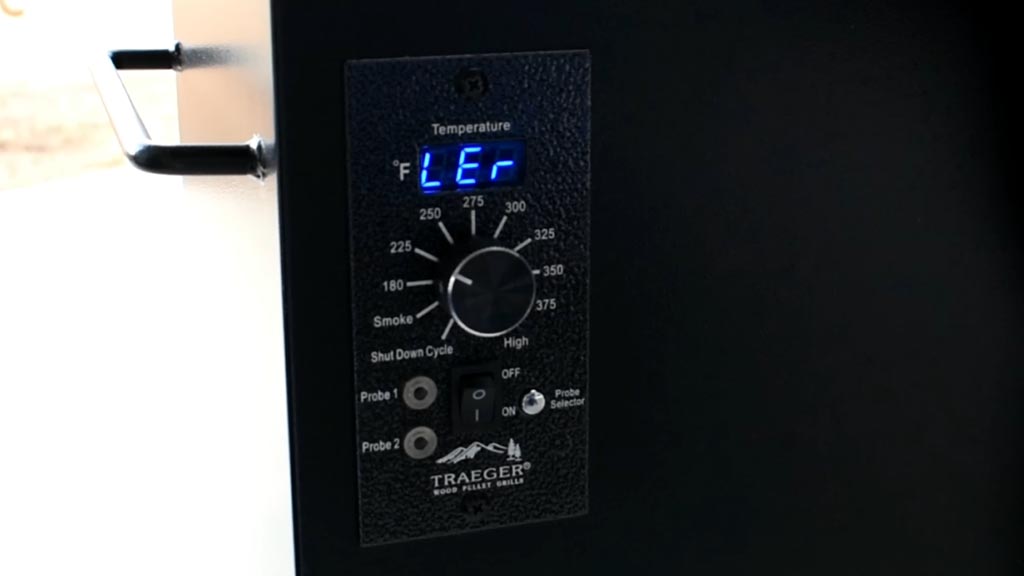
The quickest way to tackle the LEr error is to power cycle your grill. So, how to power cycle the Traeger grill?
It’s a simple process. You just have to turn the grill off and back on. Start by switching off the grill, unplugging it from the outlet, and waiting about 10-15 minutes.
Then, plug it back in and turn it on again. Most of the time, this little trick clears the error, and your grill will fire up like usual. But if the error doesn’t go away after a power cycle, it could mean there’s a deeper issue at play.
In that case, you’ll need to dig a little deeper to troubleshoot or get your grill repaired. Think of it as your grill waving a red flag, asking for extra attention to get back to perfect grilling mode.
How to Fix LEr Code On Traeger
If the Traeger LEr code reset didn’t fix the issue, you will have to dig deep and start diagnosing. But don’t worry, I’ll walk you through all the problems and the relevant solutions in this section.
1. Bad Weather Conditions
Cold or windy days giving your grill trouble? The LEr error code often pops up when your grill struggles to maintain the right temperature. This usually happens with smaller Traeger grills, especially in extreme weather.
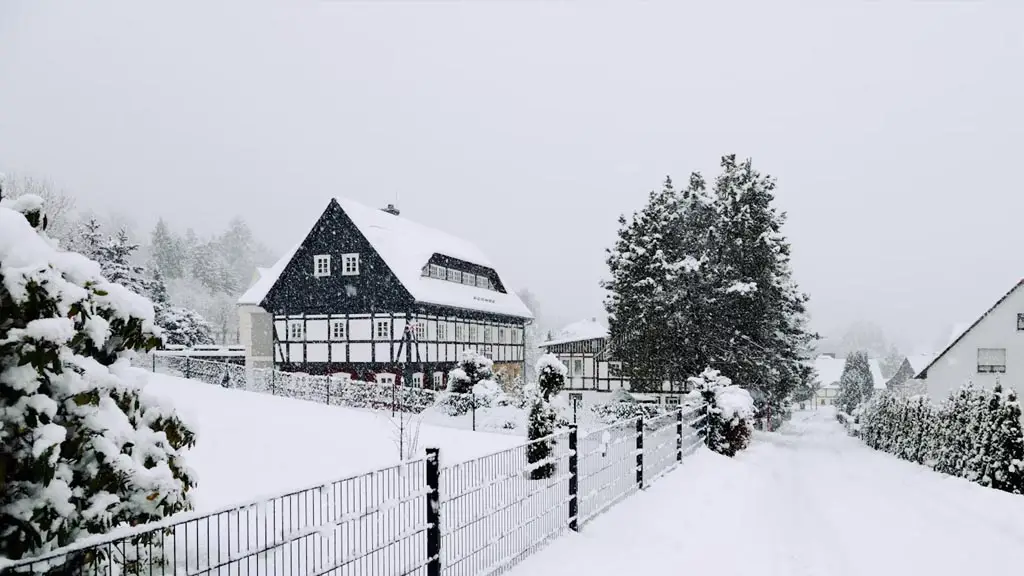
So, why does this happen? Cold air makes it harder for the grill to heat up, while wind can blow the heat away, causing temperature drops.
When your grill can’t hold steady at 125°F for at least 10 minutes, the LEr code kicks in as a safety feature. But don’t worry, you can fix it!
Solution:
First, check the weather. Is it freezing cold or super windy? If so, try moving your grill to a more sheltered spot. A covered porch or garage can work wonders to block out the wind and keep the chill off your grill.
For extra protection, consider using a weather shield or an insulation blanket. These add an extra layer of defense, helping your grill stay warm even on tough days.
However, keep in mind that grills aren’t invincible. In extreme weather, your grill will need to work harder and might take longer to heat up or hold high temperatures. Think of it as swimming against the current—possible, but it takes more effort.
With a bit of patience and these simple adjustments, your grill will still get the job done, and you can keep serving up delicious meals no matter the weather!
2. Incorrect Startup Procedure
If you’ve ever had the LEr code pop up on your Traeger grill, it might be because you didn’t start it properly. This error happens when the grill’s temperature drops below 125°F (52°C) for over 10 minutes.
Most of the time, this is due to a few simple mistakes: the auger wasn’t primed, the hopper settings were off, or the grill wasn’t prepped correctly before ignition.
These missteps can mess with how pellets feed into the firepot, causing the system to fail and triggering the error code. Cold or windy weather can make this issue even worse, especially for smaller grills, which tend to struggle more in extreme conditions.
Solution:
To prevent the LEr code, you need to get the startup process right every time. First, prime the auger to ensure pellets flow smoothly into the firepot.
Next, double-check that the hopper is filled with quality pellets and set everything up according to the manual.
Take your time—don’t rush the startup process, even if you’re eager to cook. Skipping steps or rushing through the ignition phase can cause temperature swings, making the LEr code more likely.
Remember, a slow and steady approach at the start will save you a lot of frustration later on. It’s worth the extra effort to avoid problems down the line!
3. Pellet Problems
If you’re dealing with the LEr error on your grill, poor pellet quality might be the culprit. Wet, old, or cheap pellets often fail to ignite properly, making it tough for the grill to maintain a steady temperature.
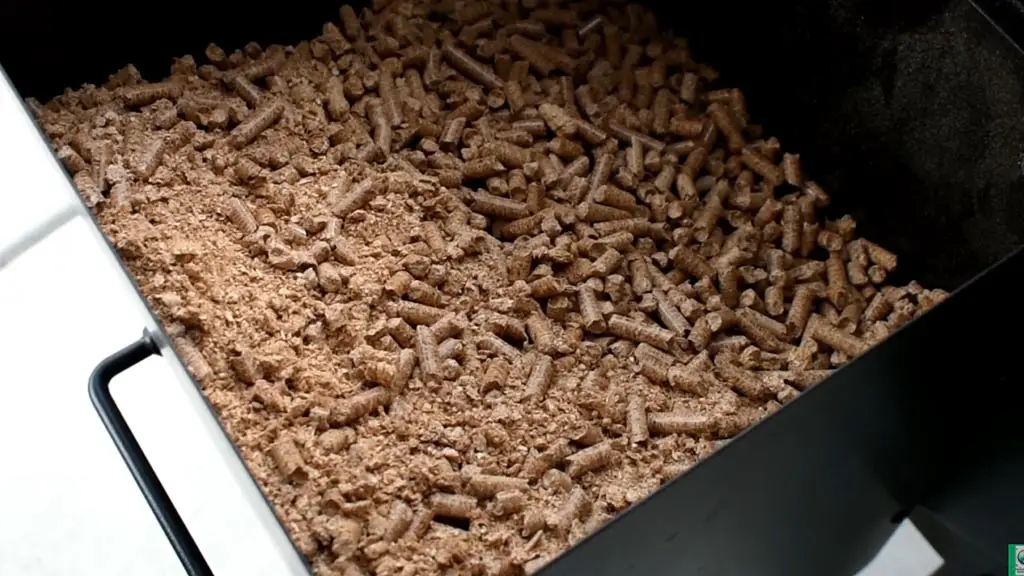
This inconsistency can cause the fire to go out and trigger the error. It’s like trying to build a campfire with damp wood—it’s just not going to work.
Solution:
Always make sure you’re using dry, high-quality pellets. Premium pellets burn evenly and keep the heat steady, which helps prevent the grill from shutting down unexpectedly.
If the pellets are old or have absorbed moisture, toss them out and start fresh. Keeping them stored in a dry, sealed container can make a world of difference.
4. Firepot Troubles
Firepot issues can stir up trouble for your grill, often triggering the LEr error. One common problem is when there are no pellets in the firepot. This usually happens because of auger jams or tunneling.
Tunneling occurs when pellets get stuck in the hopper and don’t make their way down to the firepot. Without enough pellets, your grill won’t be able to keep the heat alive.
On the flip side, too many pellets in the firepot can also cause headaches. If the firepot gets overcrowded with pellets, ash, or sawdust, it blocks the airflow.
Without proper airflow, the pellets can’t ignite properly, and the grill will struggle to maintain the temperature you need. Think of it as trying to breathe through a straw. It’s not easy when things are clogged up.
Over time, ash, sawdust, and leftover pellets can pile up in the firepot. This buildup can mess with airflow and make it harder for the pellets to ignite.
Solution:
To make the LEr code disappear and keep things running smoothly, give your firepot a regular cleanup.
Clear out any ash, sawdust, or extra pellets hanging around. A clean firepot ensures good airflow, proper ignition, and steady heat for grilling.
By staying on top of firepot maintenance, you can avoid those frustrating LEr errors and keep your grill working like a charm. After all, a little elbow grease now saves you from bigger headaches down the line.
It’s also a good idea to check the firepot regularly. Make sure there’s enough fuel in there to keep the fire burning strong. If the firepot is running low on pellets, the grill won’t be able to keep up the required heat.
5. Chimney Blockages
The chimney on your grill is like its lungs. It helps oxygen flow in and keeps the fire burning strong. But when the chimney gets blocked or clogged with debris, it messes with this airflow.
Without proper oxygen, the fire can’t burn the way it should, and that’s when your grill starts acting up, often showing the dreaded LEr error code.
Solution:
If you notice your grill struggling to maintain heat, take a quick look at the chimney. A little cleaning or adjustment might be all it needs to get back on track. Keeping the chimney in good shape ensures your grill stays consistent, reliable, and ready to cook up a storm every time.
To make the Traeger smoker LEr code disappear, make sure your chimney is always clear and open. Check it regularly for any debris or buildup that might be causing a blockage.
Sometimes, adjusting the chimney height by twisting the cap can make a big difference in improving airflow. Think of it as giving your grill a little extra room to breathe.
6. Incorrect P Settings
The P-setting on your grill plays a big role in controlling how pellets are fed into the firepot. When this setting is off, it can mess up the pellet feeding process.
This leads to uneven heat, making it hard for your grill to maintain the right temperature. If things get bad enough, you might see the LEr error pop up, which is a clear sign your grill is struggling to keep the fire going.
When the P-setting is too high, pellets feed too slowly, and the fire may die down. On the flip side, if it’s too low, pellets might overload the firepot, causing temperature swings or even smothering the flame.
Solution:
You’ll have to adjust the P setting to resolve this issue and make the LEr code disappear. The good news is that adjusting the P-setting is simple.
If your grill isn’t getting enough pellets, try lowering the P-setting to a smaller number. This ensures pellets are fed steadily into the firepot, keeping the fire burning strong and consistent.
Keep an eye on your grill’s performance after making adjustments. If the temperature stabilizes and the LEr error doesn’t reappear, you’ve likely found the sweet spot.
Regularly checking and fine-tuning the P-setting can help your grill run smoothly and maintain the perfect heat for cooking.
7. Faulty Parts
Alright, if your grill’s been acting up and you’ve already checked all the obvious stuff, then it might be time to look inside. Sometimes, the LEr code points to an internal part not working properly.
It could be something like the induction fan, the RTD (Resistance Temperature Detector), or the hot rod. If any of these go bad, your grill won’t hold the right temperature, and you’ll get that pesky LEr error.
Solution:
Now, you’ve got to dig in and check these parts individually. Yeah, it can be a little time-consuming, but it’s the only way to figure out what’s going wrong. Here’s what you need to look at:
i) Controller and RTD Check
The controller and RTD are crucial for keeping your grill at the right temperature. If these are faulty, you might have trouble getting the right heat, which will set off the LEr error.
Start by testing the controller settings. Then, check the RTD—if it’s giving off weird readings, it might need to be replaced.
ii) Induction Fan, Hot Rod, and Auger Motor Check
The fan, hot rod, and auger motor all play a huge role in making sure your grill runs smoothly. The fan circulates air for combustion, the Hot Rod ignites the pellets, and the auger motor moves pellets into the firepot.
Check each of these components to make sure they’re doing their job. If the fan isn’t running, the Hot Rod isn’t heating, or the auger motor isn’t feeding pellets, your grill won’t reach the right temperature, and the LEr code will show up.
iii) Fan Issues
If the fan’s acting up, it could mess with the airflow, making it hard for the grill to heat up properly. Listen for any odd sounds like squeaks or if the fan is silent when it should be running.
If the fan’s not working, it could be blocked or faulty. Start by cleaning it out, and if that doesn’t help, you might need a new one.
iv) Heat and Pellet Flow
The Hot Rod needs to heat up the pellets to keep the grill hot, and the pellets should fall correctly from the hopper into the firepot.
If the Hot Rod isn’t heating or the pellets aren’t flowing right, the grill won’t reach the temperature it needs, and you’ll get the LEr error.
Make sure the Hot Rod is heating properly, and check that the pellets are feeding consistently into the firepot.
Once you check all these parts, you’ll have a better idea of what’s causing the issue and can take the necessary steps to fix it. Hopefully, that’ll solve the LEr error and get your grill back to cooking!
What To Do If The Traeger LEr Code Still Remains?
If you’ve followed all the troubleshooting steps and the LEr error is still showing up, it might be time to reach out to customer support.
Sometimes, the issue could be a mechanical problem, like a broken induction fan, hot rod, or auger motor. These parts might need to be repaired or replaced by a professional.
Traeger’s customer support team is available to help diagnose the issue and can guide you through the process of getting the parts you need or arranging for repairs if required. So, don’t hesitate to get in touch if you’re stuck. You’ve already tried everything you could do from your end.
How to Prevent The Traeger LEr Message?
Taking care of your Traeger grill will keep it running smoothly and help prevent issues like the LEr error. Regular maintenance not only boosts performance but also extends your grill’s life. Here are some simple steps to follow:
i) Clean the Firepot, Hopper, and Chimney Regularly
It’s crucial to clean the firepot, hopper, and chimney often. Ash, sawdust, and leftover pellets can pile up over time and block airflow, leading to problems like temperature drops or pellet feeding issues.
After every use, clean the firepot to remove ash buildup. Don’t forget to clean the hopper and chimney, too. Clear any debris from the chimney and remove excess pellets from the hopper to keep things running smoothly.
ii) Store Pellets Properly
The quality of pellets has a huge impact on the grill’s performance. Moisture is the enemy here. That’s because wet pellets can fail to ignite, put out the fire, or clog the auger.
To avoid this, store pellets in a dry area away from humidity and seal the bag tightly. If you leave pellets in the hopper for a while, make sure they stay dry.
Using high-quality pellets will also reduce the risk of clogging and improve your grilling experience.
iii) Check the Auger, Induction Fan, and Hot Rod Frequently
Make it a habit to check critical parts like the auger, induction fan, and hot rod. The auger feeds pellets into the firepot, so check it for jams or clogs. Clear any pellet buildup that’s blocking its path.
The induction fan circulates air for combustion, so if it starts making strange noises or the airflow is weak, clean it or replace it if needed.
Finally, the hot rod ignites the pellets. Make sure it’s heating properly, and replace it if it’s no longer working efficiently.
iv) Prepare Your Grill for Extreme Weather
Extreme weather can take a toll on your Traeger grill, especially in cold or windy conditions. Here’s how to protect it:
- Cover the Grill: Invest in a weather-resistant cover to protect your grill from rain, snow, or dirt.
- Move to a Sheltered Spot: If you can, place your grill in a more protected area, like a porch or garage, to shield it from wind and rain.
- Adjust Temperature Settings: In cold weather, your grill may struggle to keep the temperature up. Turn it up a little to help compensate for the cold air.
- Use an Insulation Blanket: For extreme weather, consider using an insulation blanket made for your grill model. This helps keep the temperature stable and reduces strain on the heating system in low temperatures.
By following these simple maintenance tips, you’ll avoid many issues that can lead to the LEr error and enjoy better grilling all year long.
FAQs:
Can I use my Traeger grill in the rain with an LEr error?
It’s not recommended to use the grill in the rain while experiencing a LEr code. Moisture can affect the grill’s performance and potentially worsen the issue.
How often should I calibrate the traeger probe?
You should calibrate your Traeger probe at least once a year or whenever you notice a significant temperature discrepancy. Regular calibration ensures accurate temperature readings and optimal cooking performance.
How often should I clean the firepot to prevent LEr errors?
Clean the firepot regularly, especially after every few uses. You should do that because accumulated ash and pellets can block airflow, preventing proper ignition and causing errors like LEr.
Does the LEr error affect the grill’s warranty?
An LEr error itself does not void the warranty. However, if it’s caused by improper maintenance or user error, it may not be covered.
Can I troubleshoot the LEr error without calling customer support?
Yes, many issues related to the LEr code can be fixed by following the troubleshooting steps. However, if the error persists, contacting customer support for further assistance is advised.
Conclusion
Now that you understand why the Traeger LEr code appears and how to resolve it, I hope the solution is a quick and simple fix for you. Power cycling the grill usually clears the error, but if it persists, checking the pellets, firepot, and weather conditions should help.
Follow the steps in this guide if the error remains. If you’re still facing trouble, don’t hesitate to contact Traeger customer support for further assistance. If you run into any other error codes with your Traeger grill, I’ve got dedicated guides for each one. Be sure to check them out for more solutions!
